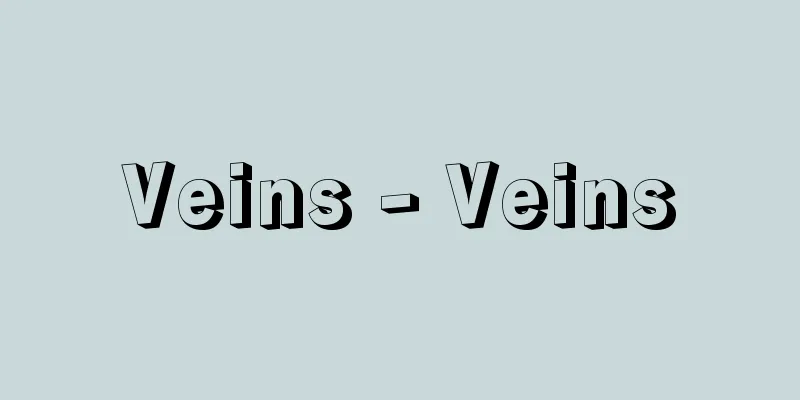Veins - Veins

|
These are blood vessels that carry blood from the capillaries to the heart. The veins of the entire body can be divided into superficial and deep veins depending on where they run. Superficial veins are so-called subcutaneous veins, and run independently of arteries in the subcutaneous tissue. Subcutaneous veins appear pale through the skin, and their course can be seen from the surface of the skin. Subcutaneous veins collect blood from superficial tissues and connect to deep veins. The median cutaneous vein on the front of the elbow and the median cutaneous vein on the forearm are thick subcutaneous veins that are often used for intravenous injections. Subcutaneous veins on the lower abdomen and back of the lower leg tend to accumulate venous blood due to blood flow disorders in the deep veins, and can be seen to swell and twist like an earthworm. This is called varicose veins, and is commonly seen in middle-aged women, especially elderly people and pregnant women, and is also common in people who work standing up. Deep veins generally run alongside arteries, surrounded by the same connective tissue capsule. In the case of large arteries (subclavian, axillary, femoral, and popliteal arteries), only one vein runs parallel to the artery, while in the case of smaller arteries (brachial, radial, ulnar, tibial, and peroneal arteries), the veins usually run in pairs on either side of the artery. These are called accompanying veins. Veins in special organs (skull, spinal canal, and liver) do not run alongside arteries. The area where the lumen of a blood vessel becomes particularly wide due to adhesion with the surrounding tissue is called a venous sinus, where venous blood accumulates and blood flow slows. When veins branch out into a network, this is called a venous network, and when this is structured three-dimensionally, it is called a venous plexus. When the venous plexus is very dense, it is called a corpus cavernosum. The structure of the vein wall, like that of arteries, can be distinguished from the inside into three layers: the tunica intima, tunica media, and tunica adventitia. When comparing veins and arteries of the same diameter, veins are generally thinner and have fewer elastic and smooth muscle fibers. The tunica intima is composed of a single layer of endothelial cells and longitudinal smooth muscle fibers, the tunica media is composed of circular smooth muscle fibers, elastic fibers, and connective tissue, and the tunica adventitia is composed of longitudinal muscle fibers, elastic fibers, and connective tissue. Veins are generally classified according to their diameter into venules, small veins, medium-sized veins, and large veins. In venules and small veins with a diameter of 1 mm or less, it is difficult to distinguish the three layers of membrane, but in medium-sized veins with a diameter of 1 mm or more, the adventitia is somewhat developed, while in large veins, the intima and adventitia are developed and thickened. In medium-sized veins and large veins with a diameter of 2 mm or more, there are venous valves throughout. These are folds of the intima that function to prevent the backflow of blood. Venous valves are generally two semicircular valves facing each other, but small veins may have only one. Venous valves are common in the veins of the hands and feet, which is why varicose veins are more likely to develop in the lower limbs. The veins of the head, jugular veins, umbilical veins, hepatic veins, pulmonary veins, uterine veins, and portal veins do not have valves. Arteries generally transition into veins via capillaries, but sometimes arterioles and venules connect directly without going through capillaries. This is called arteriovenous anastomosis (leading circulation), and is developed in the skin of the finger pads and the nasal mucosa. Arteriovenous anastomosis has the role of accelerating blood flow and regulating temperature. In addition, the veins in the cranial cavity connect to large veins, and also penetrate the skull and connect to the cutaneous veins of the head; these are called emanating veins. Nutrients are supplied to the venous walls by nutrient blood vessels, that is, blood vessels of the vasa vasculature. Veins are supplied with nerves, just like arteries, but there are fewer of them than in arteries. [Kazuyo Shimai] The circulatory system is a system of fluid transport that supplies nutrients and oxygen to all cells and tissues in the human body and expels waste materials and carbon dioxide. Blood is transported through the blood vessels, and lymph is transported through the lymphatic system. In addition, there is the cerebrospinal fluid circulatory system and the open interstitial fluid system that flows between tissues . The human circulatory system (vascular system) ©Shogakukan "> Blood Vessel Structure ©Shogakukan "> Schematic diagram of the vascular system Source: Shogakukan Encyclopedia Nipponica About Encyclopedia Nipponica Information | Legend |
|
全身の血液を毛細血管から心臓へと運ぶ血管をいう。全身の静脈はその走る部位によって浅静脈と深静脈に分けることができる。浅静脈はいわゆる皮下静脈で、皮下組織中を動脈とは平行せず単独で走っている。皮下静脈は皮膚を通して青白くみえ、その走行は皮膚表面からもわかる。皮下静脈は浅層の組織からの血液を集め、深静脈と連絡している。肘(ひじ)の前面にある肘(ちゅう)正中皮静脈や前腕正中皮静脈などは太い皮下静脈で、静脈注射によく用いられる。下腹部や下腿(かたい)後面の皮下静脈は、深静脈の血流障害により静脈血がたまりやすく、膨らんでミミズのようにうねうねと蛇行しているのをみることがある。これが静脈瘤(りゅう)とよばれるもので、中年以後の女性、とくに老人や妊婦に多くみられ、立ち仕事に従事する者にも好発する。 深静脈は一般に動脈に伴って同じ結合組織性被膜内に包まれて走っている。太い動脈(鎖骨下動脈、腋窩(えきか)動脈、大腿動脈、膝窩(しっか)動脈)の場合は静脈は1本だけ平行に走り、それより細い動脈(上腕動脈、橈骨(とうこつ)動脈、尺骨(しゃくこつ)動脈、脛骨(けいこつ)動脈、腓骨(ひこつ)動脈)では通常、静脈は対(つい)をなして動脈の両側を走る。これを伴行静脈とよぶ。また、特殊な器官(頭蓋骨(とうがいこつ)、脊柱管(せきちゅうかん)、肝臓)の静脈は動脈に伴行しない。 静脈が周囲の組織と癒着して血管の内腔(ないくう)がとくに広くなっている部分を静脈洞とよび、この部分には静脈血がたまって血流は遅くなる。静脈が細かく枝分れして網の目をつくっているのが静脈網で、これが立体的に構成されたものを静脈叢(そう)とよぶ。さらに静脈叢が非常に緻密(ちみつ)に構成されている場合には海綿体とよぶ。静脈壁の構造は、動脈と同様に内側から内膜、中膜、外膜の3層を区別することができる。同じ太さの静脈と動脈とを比べると、一般に静脈のほうが薄くて弾性線維や平滑筋線維も少ない。内膜は1層に配列する内皮細胞層と縦走の平滑筋線維、中膜は輪走の平滑筋線維、弾性線維と結合組織など、外膜は縦走筋線維、弾性線維と結合組織から構成されている。 静脈は一般にその太さによって、細静脈、小静脈、中等大の静脈、太い静脈に分けられる。直径が1ミリメートル以下の細静脈・小静脈では3層の膜を区別しにくいが、1ミリメートル以上の中等大の静脈ではやや外膜が発達し、太い静脈では内膜、外膜が発達し、厚くなっている。また、直径が2ミリメートル以上の中等大の静脈や太い静脈の内部には至る所に静脈弁がある。これは内膜が折り返されたもので、血液の逆流を防ぐ働きをもっている。静脈弁は、一般には半月形の弁が2枚相対しているが、小さい静脈では1枚の場合もある。静脈弁は手足の静脈に多く、静脈瘤が下肢にできやすいのもこのためである。なお、頭蓋の静脈、頸静脈(けいじょうみゃく)、臍静脈(さいじょうみゃく)、肝静脈、肺静脈、子宮の静脈や門脈には弁がない。 動脈は毛細血管を経て静脈に移行するのが一般であるが、毛細血管を介しないで直接、細動脈と細静脈がつながる場合がある。これを動静脈吻合(ふんごう)(誘導循環)とよび、指腹部の皮膚、鼻粘膜に発達している。動静脈吻合は、血流を迅速にして温度を調節するという役割をもっている。また、頭蓋腔内の静脈は太い静脈につながるほか、頭蓋骨を貫いて頭部の皮静脈と結合しているが、これを導出静脈という。静脈壁の栄養供給は栄養血管、つまり脈管の血管がこれを行う。静脈には動脈と同じように神経が分布しているが動脈に比べ少数である。 [嶋井和世] 循環器系は人体のあらゆる細胞、組織への栄養や酸素の供給、老廃物質や炭酸ガス(二酸化炭素)の排除のための体液の輸送路で、血液は血管系、リンパ(液)はリンパ管系で輸送される。このほか、脳脊髄液循環系や組織間隙を流れる開放型の組織液系もある©Shogakukan"> 人体の循環器系(血管系) ©Shogakukan"> 血管の構造 ©Shogakukan"> 血管系の模式図 出典 小学館 日本大百科全書(ニッポニカ)日本大百科全書(ニッポニカ)について 情報 | 凡例 |
>>: The Sacred Wisdom Sutra - Shomangyo
Recommend
Ansariya [Mountain Range] - Ansariya
… [Nature] The country is divided into a narrow w...
Ligularia dentata (English spelling) Ligulariadentata
… [Mitsuru Hotta]... *Some of the terminology tha...
Fenestraria aurantiaca (English spelling)
…One of the most unique shapes is the lenticular ...
Oliver Wendell Holmes
1809‐94 American physician, poet, and writer. He s...
Choro
A popular urban music that was perfected in Brazil...
Black Tartary Strategy
A miscellaneous history of China. One volume. Writ...
Pfann, WG (English spelling) PfannWG
...A melting method in which a narrow band of hea...
Zhao Mengfu - Cho Mofu
He was a Chinese government official, calligraphe...
Everett's Interpolation Formula - Everett's Interpolation Formula
...For example , a table of function values, such...
Outcrop - Roto
This refers to places where strata or rocks are e...
Farmers' profits
A book on agriculture. Okura Nagatsune's debu...
Fujiokaya Diary - Fujiokaya Diary
This is a collection of records centered on Edo fr...
"Omuro Japanese Book Catalog"
...1 volume. Also known as the Omurowasho Mokurok...
Akiyoshiera - Akiyoshiera
...The eastern part of the area, Akiyoshidai in t...
copper head
...The American cottonmouth A. piscivorus (water ...









